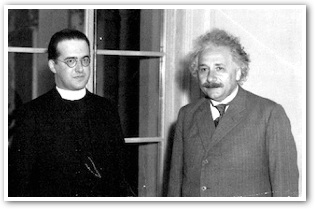The Hubble–Lemaître Law
- FATHER RAYMOND J. DE SOUZA
Lemaître had no trouble at all seeing how faith — divine creation out of nothing — and the Big Bang, which seems to look just like that, were compatible.
 Monsignor Georges Lemaïtre
Monsignor Georges Lemaïtre & Albert Einstein, 1933
Thanks to the Hubble telescope, even those unfamiliar with astronomy have heard the name of Edwin Hubble. Those more familiar with the subject will know of Hubble's Law, which is about to be renamed the "Hubble–Lemaître Law," overdue recognition for the astronomer and Belgian priest, Monsignor Georges Lemaître, the father of the Big Bang theory.
Father Lemaître's recognition is a good occasion to remember not to mix up astronomy with philosophy, physics with metaphysics. When elementary Greek philosophy was taught in high school, as it was in the time of Hubble and Lemaître a century ago, the different disciplines were rarely confused or conflated. Today, a great many scientists do just that, and would find it hard to understand a figure like Father Lemaître, a Catholic priest and one of the century's leading astronomers.
The International Astronomical Union vote to rename the law was announced this week after a worldwide consultation with its members. The "Hubble-Lemaître" law describes the speed at which objects move in an expanding universe. The specifics are beyond a newspaper column — and this columnist. But general principles are accessible to lay interest.
By the 1920s astronomy had reached a widespread consensus that the universe was in a perpetual "steady state," that it had always existed. That working consensus avoided having to conjure with the physics of how something so enormous could be assembled, as it were, and where it would come from.
Lemaître, a mathematician who read astronomy after his theological studies, argued that the universe began at a distinct moment, with all of its mass in an unimaginably dense quantum. He then likened that first moment to fireworks, with the resulting galaxies like the trails of burning embers that are launched away from the central burst.
So the universe had a beginning, after which time and space made sense, as there was now change and motion. When did the universe begin? Lemaître, who had a facility for expression, referred to it as "a day without yesterday."
The astronomy guild did not appreciate its consensus being disturbed, and what we now call the "Big Bang" theory was coined by a critic and intended as derogatory. Yes, everything just went "bang" in the beginning, and unfolded from there! Ridiculous.
Despite later disagreements, Albert Einstein greatly admired Lemaître's work, with the two of them travelling to California in 1933 for a series of seminars on their respective work.
"This is the most beautiful and satisfactory explanation of creation to which I have ever listened," said Einstein of Lemaître's theories on their joint trip.
Einstein did not by "creation" mean the biblical account of a personal God who creates out of love, but Lemaître had no trouble at all seeing how faith — divine creation out of nothing — and the Big Bang, which seems to look just like that, were compatible.
The Big Bang theory, which now meets with wide acceptance, requires that there be something to go "bang" in the first place. And where did that come from? What was there before there something to go bang? Nothing?
The prior consensus on the cosmos was reluctant to accept the idea of a "beginning." It sounded rather too much like the first words of the Hebrew bible: "In the beginning, God created ..."
And if nothing, how could something come from it? That's metaphysics now, of which astronomy can tell us nothing. Astronomy, like all branches of physics, requires there be something to observe before it can do its work.
The Big Bang, despite being used by scientists weak in metaphysics to "explain" that the origins of the universe exclude divine creation, actually points — suggestively, but not definitively — to a complementarity between astronomy and biblical revelation, righty understood.
The prior consensus on the cosmos was reluctant to accept the idea of a "beginning." It sounded rather too much like the first words of the Hebrew bible: "In the beginning, God created …"
So an alternative "steady state" was proposed, in which the emissions from the Big Bang accelerated away from the central burst, but at a decreasing rate of acceleration due to gravitational force. Eventually the force of gravity would overcome the initial momentum from the Big Bang, and the universe would slow down until the expansion was reversed, and gravity pulled the mass of the universe back toward the centre, leading to everything disappearing in a "big crunch." Thereupon would follow another Big Bang and so on it would go, the universe constantly creating and destroying itself, expanding and contracting, banging and crunching.
Lemaître did not follow that line, likely influenced by the biblical idea of creation being a singular event, not an infinitely iterative process. But wherever Lemaître's intuition came from, it would be evidence that would determine the truth. In 1998, astronomers observing supernovas — exploding stars — found that the rate of acceleration were increasing, not decreasing. Bang but no crunch.
Lemaître's work, now vindicated, has long been overlooked in favour of other astronomers to which he was equal or superior. That was due, in part, to anti-religious prejudice. Scientists think of themselves as being without prejudices, another widely believed proposition for which there is a lack of evidence.
 This is J. Fraser Field, Founder of CERC. I hope you appreciated this piece. We curate these articles especially for believers like you.
This is J. Fraser Field, Founder of CERC. I hope you appreciated this piece. We curate these articles especially for believers like you.
Please show your appreciation by making a $3 donation. CERC is entirely reader supported.

Acknowledgement
 Father Raymond J. de Souza, "The Hubble–Lemaître Law." National Post, (Canada) November 3, 2018.
Father Raymond J. de Souza, "The Hubble–Lemaître Law." National Post, (Canada) November 3, 2018.
Reprinted with permission of the National Post and Fr. de Souza.
The Author
Father Raymond J. de Souza is the founding editor of Convivium magazine.
Copyright © 2018 National Post

